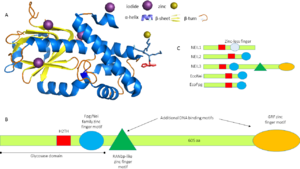User:Abbas Raza/Sandbox 1
From Proteopedia
Contents |
NEIL3: a DNA repair glycosylase from mus musculus
|

This protein is a unique member of family of DNA glysosylases, family of base excision repair enzymes that show preference for both oxidative purines and pyrimidine lesions. For a description of all known DNA glycosylases and their families see the wikepedia page on DNA glycosylases [[1]]. Originally identified through in-silico studies from Wallace, Mitra and Seeger group back in 2002(add reference), the crystallisation of neil3 remained challenge for almost a decade due to the difficulty in getting a stabilized form of the protein as it tend to aggregate until a truncated version was crystallised in 2013 and the crystal structure publlished (add reference).
Neil3 proteins are almost twice the size of other Fpg/Nei family members. The N terminus of the Neil3 proteins is highly conserved, with a complete Fpg/Nei-like core protein that harbors an H2TH motif and a canonical zinc finger motif. Neil3 proteins also have a Ran binding protein (RanBP2)-type zinc finger motif and a duplicated GRF-zinc finger motif at their extended C terminus (Bandaru et al., 2002; Krokeide et al., 2009; Liu et al., 2010; Morland et al., 2002; Takao et al., 2009; Torisu et al., 2005)
You may include any references to papers as in: the use of JSmol in Proteopedia [1] or to the article describing Jmol [2] to the rescue.
Function
== Disease
Relevance
Structural highlights
This is a sample scene created with SAT to by Group, and another to make of the protein. You can make your own scenes on SAT starting from scratch or loading and editing one of these sample scenes.
</StructureSection>
References
- ↑ Hanson, R. M., Prilusky, J., Renjian, Z., Nakane, T. and Sussman, J. L. (2013), JSmol and the Next-Generation Web-Based Representation of 3D Molecular Structure as Applied to Proteopedia. Isr. J. Chem., 53:207-216. doi:http://dx.doi.org/10.1002/ijch.201300024
- ↑ Herraez A. Biomolecules in the computer: Jmol to the rescue. Biochem Mol Biol Educ. 2006 Jul;34(4):255-61. doi: 10.1002/bmb.2006.494034042644. PMID:21638687 doi:10.1002/bmb.2006.494034042644
